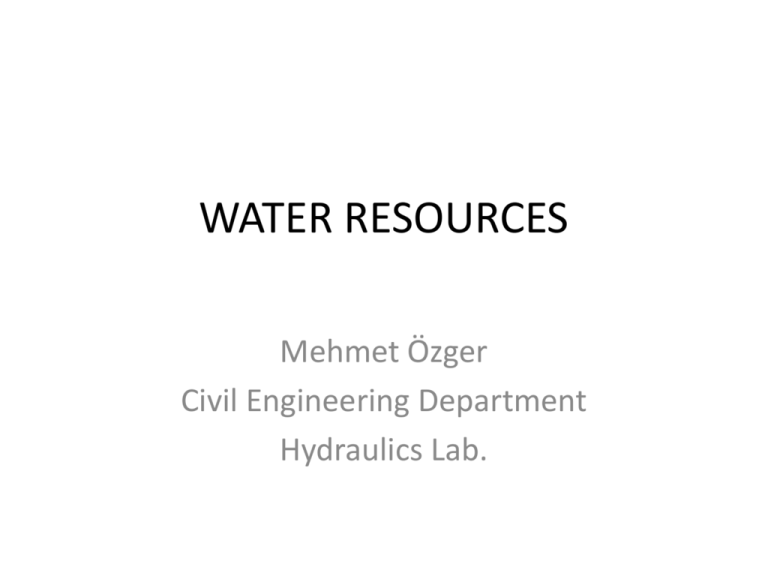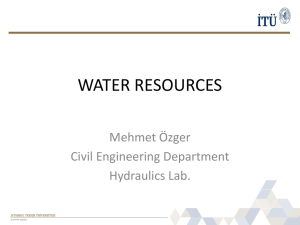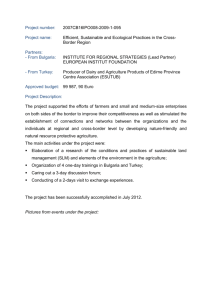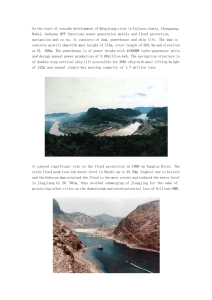water resources
advertisement

WATER RESOURCES Mehmet Özger Civil Engineering Department Hydraulics Lab. Some informations about myself I usually prefer not to indicate fixed receiving hours. I am usually working in my office and therefore I am willing to receive students any time. Appointments can be fixed by email. Email: ozgerme@itu.edu.tr Phone: 212 285 3717 Web: http://web.itu.edu.tr/~ozgerme/ 2 Learning Objectives Water Resources Engineering is about solving problems to secure water for people, based on a scientific understanding of hydrologic and hydraulic processes. This includes protection from excess water and from water shortage, as well as providing sufficient water for a sustainable environment. At the end of this class you will: • be aware of water resources issues at local , national and global scale, • be able to qualitatively and quantitatively describe the main processes in the hydrologic cycle, and • be able to provide solutions for typical water resources problems found in practice. 3 Suggested text book This textbook covers the all topics included in the class. Additional textbook 4 What is Water Resources Engr./Manag.? Figure 1.1.1 (p. 1) Ingredients of water resources management (from Mays, 1996). 5 Ancient Hydrologic History Hydrology has been a subject of investigation and engineering for millennia. For example, about 4000 B.C. the Nile was dammed to improve agricultural productivity of previously barren lands. Mesopotamian towns were protected from flooding with high earthen walls. Aqueducts were built by the Greeks and Ancient Romans, while the History of China shows they built irrigation and flood control works. The ancient Sinhalese used hydrology to build complex irrigation Works in Sri Lanka, also known for invention of the Valve Pit which allowed construction of large reservoirs, anicuts and canals which still function. Nile River The longest river in the world (6650 km) 6 Loucks and van Beek, 2006 Major Reservoirs of Water 7 [does not add to 100% due to rounding, numbers differ slightly depending on study used] The water resources are composed of all • Surface water potential (rivers, lakes, …) • Underground water potential (groundwater…) Water resources system • It is a system that control, utilize and manage water in an efficient manner What are the systems: • Dams • Water supply systems • Waster water collection systems • Treatment plants • Flood mitigation • There are two significant factors for water pollution • Growing population • Advancement in technology Hydropolitics • • • • • Transboundry rivers of Turkey Euphrates (Fırat) Tigris (Dicle) Çoruh Meriç Fertile crescent E-T river basin • Headwaters are located in Turkey • Turkey contributes nearly %60 of streamflow • Turkey promises daily 500m3/s water for all seasons. • Turkey regulates the flows Floods Damage survey in St. Genevieve, Missouri, during the 1993 Midwest floods [courtesy of FEMA]. Floods cause extensive damage: “during 1991-1995, flood related damage totaled more than US$200 billion (not inflation adjusted) globally, representing close to 40% of all economic damage attributed to natural disasters in the period -- (Pielke Jr. and Downton, 2000, citing IFRCRCS, 1997). In the United States, annual flood damage runs in the billions of dollars (Pielke Jr. and Downton, 2000). Improved prediction of floods could reduce these costs substantially, in addition to reducing flood-induced loss of 14 life. Droughts 15 Characteristics of water resources projects • • • • • • Uniqueness Uncertainty Socio-economic aspects Forecasting (energy demand forecasting) Irreversibility Economy of scale Problems face us: • • • • • • Growing population in developing countries Uncertain impacts of climate change Conflicts over shared frehwater resources Thinning of ozone layer Destruction of rain forest Threats to wetlands, farmlands and other renewable sources Water resources development in Turkey • Completion and renewal of water supply and waste water collection systems • Watershed management • Development of flood mitigation facilities • Searching for navigational facilities Organizations responsible for water • Ministry of Forestry and Water Affairs – State hydraulic works (DSİ) – Water management directorate general – State meteorological organization (DMİ) Ongoing big projects in Turkey • Water transfer to North Cyprus • Deriner Dam Water transfer to North Cyprus • expected to cost at least 1 billion Turkish liras, or $550 million, • using an experimental technology: a pipeline in the Mediterranean Sea. • But environmental experts question the sustainability of transferring water out of its natural basin, • The project calls for Turkey to transfer 75 million cubic meters of water a year to Northern Cyprus. Deriner Dam • is a concrete double-curved arch dam on the Çoruh River • Highest 6th dam all over the World • Capacity: 670 MW İzmit bay bridge Total length: 2800m Main span: 1500m Height of pylons: 230m






